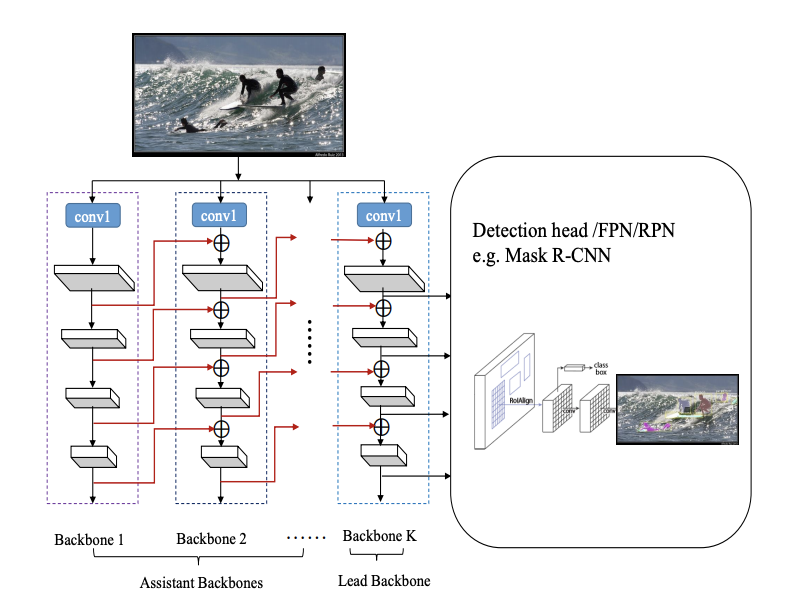Awesome
Introduction
Currently support tensorflow in
- ResNeSt 2d&3d
- RegNet
- DETR (modified classfication)
- GENet (2020 GPU-Efficient Network)
model only, no pertrain model for download (simply not enough free time and resource).
easy to read and modified. welcome for using it, ask question, test it, find some bugs maybe.
ResNeSt based on offical github .
Update
2020-7-30: Add and based on GENet: A GPU-Efficient Network. Paper shows achieve good performence under GPU environment, very similar to RegNet. model name GENet_light, GENet_normal, GENet_large.
2020-6-14: Add Resnest3D, thanks to @vitanuan, model name resnest50_3d, resnest101_3d, resnest200_3d, input shape is 4d like input_shape = [50,224,224,3]
2020-6-5: Add DETR (res34, resNest50 backbone) End-to-End Object Detection with Transformers, Experiment and inovation model, i slightly modified it into a classficaiton verison. Free to try.
2020-5-27: ResNeSt add CB-Net style to enahce backbone. theoretically, it should improve the results. Wait for test.
Usage
usage is simple:
from models.model_factory import get_model
model_name = 'ResNest50'
input_shape = [224,244,3]
n_classes = 81
fc_activation = 'softmax'
active = 'relu' # relu or mish
model = get_model(model_name=model_name,
input_shape=input_shape,
n_classes=n_classes,
fc_activation=fc_activation,
active=active',
verbose=False,
)
model.compile(optimizer='adam', loss=tf.keras.losses.BinaryCrossentropy())
model.fit(...)
- if you add CB_Net in ResNeSt: add
using_cb=Truelike:
"""
Beware that if using CB_Net, the input height and width should be divisibility of
2 at least 5 times, like input [224,448]:
[224,448]<->[112,224]<->[56,112]<->[28,56]<->[14,28]<->[7,14]
correct way:
[224,224] downsample->[112,112],
[112,112] upsample->[224,224],
then [224,224]+[224,224]
incorrect way:
[223,223] downsample->[112,112],
[112,112] upsample->[224,224],
[223,223] != [224,224] cannt add
"""
model = get_model(...,using_cb=True)
- DETR experiment model, free to modified the transformer setting.
# ResNest50+CB+transfomer looks powerful! but heavily cost.
model_name = 'ResNest50_DETR'
#res34 not implement using_cb yet, it supporse to be a lighter verison.
model_name = 'res34_DETR'
model = get_model(...,
hidden_dim=512,
nheads=8,
num_encoder_layers=6,
num_decoder_layers=6,
n_query_pos=100)
Models
models now support:
ResNest50
ResNest101
ResNest200
ResNest269
RegNetX400
RegNetX1.6
RegNetY400
RegNetY1.6
AnyOther RegNetX/Y
res34_DETR
ResNest50_DETR
RegNet
for RegNet, cause there are various version, you can easily set it by stage_depth,stage_width,stage_G.
#RegNetY600
model = get_model(model_name="RegNet",input_shape=input_shape,n_classes=n_classes,
verbose=True,fc_activation=fc_activation,stage_depth=[1,3,7,4],
stage_width=[48,112,256,608],stage_G=16,SEstyle_atten="SE")
#RegNetX600
model = get_model(model_name="RegNet",input_shape=input_shape,n_classes=n_classes,
verbose=True,fc_activation=fc_activation,stage_depth=[1,3,5,7],
stage_width=[48,96,240,528],stage_G=24,SEstyle_atten="noSE")
details seting (from orginal paper ):

- CB-Net, using this style to enhace ResNest

DETR
- orginal is detection version with two linear out (box and cls), here only clsficaiton (with some modification), if anyone interesting in the detection version, asked and i can change to a deteciton version.
- torch version using
nn.Parameterto buildtq,k,v, but in tensorflow2.x, i tried similarVariable, but theVariableshape can't set batch dimed like(?,100,100), and model layers output are like (?,7,7,2048), So to combine Variable into model, i use a trick way, to make a fake layer out(?,100,100), and add with theVariable(100,100), Variable will become(?,100,100)then can feed intotransformer. I didnot found a better way. Again, Welcome any good ideal or suggesions.
Discussion
I compared ResNeSt50 and some RegNet(below 4.0GF) in my own project, also compared to EfficientNet b0/b1/b2. it seems EfficientNet is still good at balance in size/speed and accuracy, and ResNeSt50 performe well at accuarcy also lower in size/speed, And RegNet not that fast and acuracy not that good, seems normal.